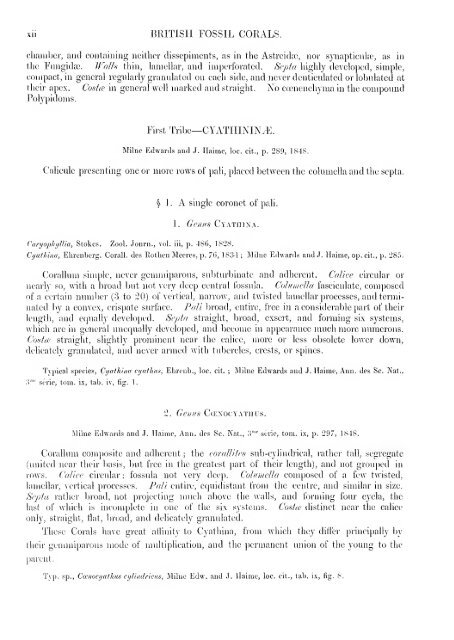A monograph of the British fossil corals - kreidefossilien.de
A monograph of the British fossil corals - kreidefossilien.de
A monograph of the British fossil corals - kreidefossilien.de
You also want an ePaper? Increase the reach of your titles
YUMPU automatically turns print PDFs into web optimized ePapers that Google loves.
xii<br />
BRITISH FOSSIL CORALS.<br />
chamber, and containing nei<strong>the</strong>r dissepiments, as in <strong>the</strong> Astreidse, nor synapticulse, as in<br />
<strong>the</strong> Fungidae. Walls thin, lamellar, and imperforated. Septa highly <strong>de</strong>veloped, simple,<br />
compact, in general regularly granulated on each si<strong>de</strong>, and never <strong>de</strong>n ticidated orlobulated at<br />
<strong>the</strong>n- apex. Costte in general well marked and straight. No coenenchyma in <strong>the</strong> compound<br />
Polypidoms.<br />
First Tribe—CYATHININiE.<br />
Milne Edwards and J. Haime, loc. cit., p. 289, 1848.<br />
CaUcule presenting one or more rows <strong>of</strong> pali, placed between <strong>the</strong> columella and <strong>the</strong> septa.<br />
§ 1 . A<br />
single coronet <strong>of</strong> pali.<br />
1. Genus Cyathina.<br />
Caryopkyllia, Stokes. Zool. Journ., vol. iii, p. 486, 1828.<br />
Cyathina, Ehrenberg. Corall. <strong>de</strong>s RotLen Meeres, p. 76, 1834 ; Milne Edwards and J. Haime, op. cit., p. 285.<br />
CoraUum simple, never gemmiparous, subtm'binate and adherent. Calice circular or<br />
nearly so, mth a broad but not very <strong>de</strong>ep central fossula. Columcllu fasciculate, composed<br />
narrow, and twisted lamellar processes, and termi-<br />
<strong>of</strong> a certain number (3 to 20) <strong>of</strong> vertical,<br />
nated by a convex, crispate surface. Pali broad, entire, free in a consi<strong>de</strong>rable part <strong>of</strong> <strong>the</strong>ir<br />
length, and equally <strong>de</strong>veloped. Septa straight, broad, exsert, and forming six systems,<br />
which are in general unequally <strong>de</strong>veloped, and become in appearance much more numerous.<br />
Costoi straight, slightly prominent near <strong>the</strong> calice, more or less obsolete lower down,<br />
<strong>de</strong>licately granulated, and never armed with tubercles, crests, or spines.<br />
Typical species, Cyathina cyathiis, Elirenb., loc. cit. ; Milne Edwards and J. Haime, Ann. <strong>de</strong>s Sc. Nat.,<br />
3"" serie, torn, is, tab. iv, fig. 1.<br />
2. Gemis Ccenocyathus.<br />
Milne Edwards and J. Haime, Ann. <strong>de</strong>s Sc. Nat., 3"" serie, torn. Lx, p. 297, 1848.<br />
CoraUum composite and adherent ; <strong>the</strong> corallites sub-cylindrical, ra<strong>the</strong>r tall, segregate<br />
(united near <strong>the</strong>ir basis, but free in <strong>the</strong> greatest part <strong>of</strong> <strong>the</strong>ir length), and not grouped in<br />
rows. Calice circular; fossula not very <strong>de</strong>ep. Columella composed <strong>of</strong> a few twisted,<br />
lamellar, vertical processes. Pali entire, equidistant from <strong>the</strong> centre, and similar in size.<br />
Septa ra<strong>the</strong>r broad, not projecting much above <strong>the</strong> walls, and forming fom- cycla, <strong>the</strong><br />
last <strong>of</strong> which is incomplete in one <strong>of</strong> <strong>the</strong> six systems. Costce distinct near <strong>the</strong> calice<br />
only, straight, flat, broad, and <strong>de</strong>licately granulated.<br />
These Corals have great affinity to Cyathina, from which <strong>the</strong>y differ principally by<br />
<strong>the</strong>ir gemmiparous mo<strong>de</strong> <strong>of</strong> multipUcation, and <strong>the</strong> permanent union <strong>of</strong> <strong>the</strong> young to <strong>the</strong><br />
parent.<br />
Typ. sp., Ccenocyathus cylindricus, Milne Edw. and J. Haime, loc. cit., tab. i.\, fig. 8.
















